Sequel of the preceding post Cosmogenesis (2) : Chaos and Metamorphosis
Time and Creation
In any discussion of the creation of the world the paradoxical and complex question of temporality inevitably arises. If the Creation is regarded as an event, it must have taken place at some point in time, on a specific date. If time is regarded as a linear phenomenon, as it is in the Western world, this necessarily raises the problem whether anything existed before the Creation and, if so, what. But if time itself existed before the Creation, it cannot be part of the world as we know it – something which is difficult to imagine…

Paris, BNF, Manuscripts, Lat. 1720.
This paradox was pondered by Medieval scholars, who were forced to conclude that the world and time were created simultaneously. In the fourth century the Bishop of Milan, St Ambrose, wrote in his Hexameron: “In the beginning of time, therefore, God created heaven and earth. Time proceeds from this world, not before the world.”[1]. In the early 13th century the French philosopher and theologian William of Auvergne (also known as William of Paris) pursued a similar line of reasoning in his thinking about time: “Just as there is nothing beyond or outside the World, since it contains and includes all things, so there is nothing before or preceding time, which began with the creation of the World, since it contains all the periods of which it is comprised. This poses the question: What was before the beginning of time? or, since the word ‘before’ implies the existence of time, In the time preceding the beginning of time, did anything exist?”[2]
The same questions continue to be asked today, and scientists who are asked to give public lectures on big bang theory and the expansion of the universe commonly face two kinds of questions: “What was there before the big bang?” and “What is there for the universe to expand into?” – in other words “Did time exist before time began?” and “Is there space beyond the limit of space?” The solution of modern physics to these paradoxes is that the universe consists of space-time and therefore the creation of the world cannot be regarded as a temporal phenomenon.
But before the development of quantum physics it was not possible to consider the origin of the universe from anything other than a temporal viewpoint. In the context of the Christian Creation story, for example, one of the fundamental questions was: did God create the world instantaneously or in stages? The various accounts of the Creation in the scriptures invite two different answers. The more widely accepted interpretation is that the Creation took place over six days (Hexameron), followed by a day of rest. The theological aspects of pre-18th century Western cosmology derive in large part from the ancient hexamerons, commentaries on Genesis by the early Church Fathers. In the fourth century AD one of the greatest of these, St Basil of Caesarea, maintained that each day of the Creation corresponded to a normal day – i.e. the 24 hours between successive passages of the sun across the meridian – whereas, according to Psalm 90, “a thousand years in thy sight are but as yesterday”[3].
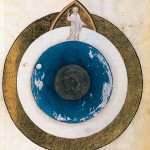 | 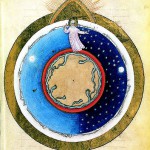 |
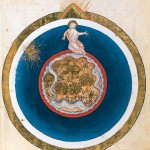 |  |
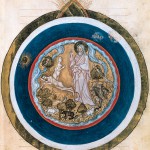 |  |
The Six Days of the Creation
This XIVth century manuscript is an unusual combination of missal and book of hours. Among its 72 miniatures are six depicting separately each stage of the hexameron according to the traditional belief in a temporal Creation. The painter belonged to the flourishing artistic community of Lombardy c. 1385-90. BNF, Manuscripts, Lat. 757.
The other interpretation of the bible story, that the Creation was instantaneous, was upheld in particular by Philo of Alexandria[4], a contemporary of Jesus, and by Origen[5], like Philo a native of Alexandria, in the third century. How else could time have started before the appearance, on the fourth day, of the two great “astronomical clocks”, the sun and the moon? Philo’s argument was that, since a day is defined in terms of the passage of the sun across the sky, there could not have been any “days” of Creation before God made the sun. This concept of an instantaneous Creation can be seen as an attempt to escape if not a belief in temporality (this could hardly have been imagined at the time), at least its astronomical implications. In doing so these early philosophers anticipated certain aspects of modern cosmology, which, despite having more sophisticated means of recording time at its disposal, is still limited by them: since 1967 the duration of a second has been officially defined in terms of the radiation from caesium 133, but no such “natural clock” could have survived the extreme temperature and intense energy of the early universe; besides, caesium had not yet been “created”…
A few Christian philosophers attempted to reconcile these two apparently contradictory views of the Creation. St Thomas Aquinas[6], for example, argued that God had created the substance of things in an instant, but that he had taken six full days to accomplish the more complex task of separating, shaping and perfecting that substance. Once again this idea seems to anticipate modern thinking: according to big bang theory the history of the universe begins with the appearance of an entity called matter-space-time, which is followed by the separation of different particles (quark era, hadron era, radiation era, etc.). But, although modern cosmological theories can account for the gradual formation of matter, from that indeterminate “quark soup” to complex structures like planets, stars and galaxies, they are still unable to describe adequately the origin of the universe.
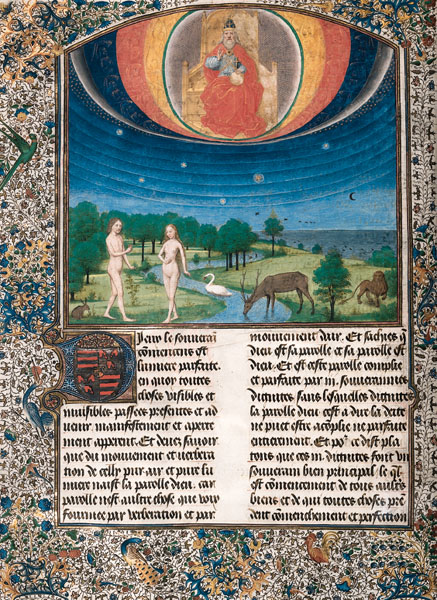
Le Livre des Sept Âges du Monde, late 15th century. Brussels, Albert I Royal Library, Manuscripts 9047
The distinction between origination and creation was made as long ago as the 13th century by Thomas Aquinas, who believed that the concept of creation could be explained rationally, whereas origination could be understood neither scientifically nor philosophically. “We may believe that there was a beginning to the World, but we can neither prove it nor explain it,” he wrote in his Summa Theologiae of 1266-73. In another work (De Aeternitate Mundi) he even refuted the argument that the world had begun at a particular time and defended the possibility that the universe, although it had been created, was eternal. Other medieval thinkers took up this idea. Albertus Magnus (c. 1200-80), for example, maintained in his Physica that “the beginning of the World was not a physical act of creation and cannot be proven as such.”
Such questions continue to exercise the minds of cosmologists everywhere, albeit within the very different conceptual framework of big bang theory. This theory is often wrongly believed to describe the origin of the universe. In fact, although it does account for the evolution of the universe from soon after its birth (estimated to have been about 13.8 billion years ago), it does not claim to be able to envisage a “zero time”, nor a fortiori the moment of creation or the origin of the universe. The extreme conditions out of which space, time, light and matter must have arisen remain beyond the reach of scientific investigation, since at the theoretical “zero time” the temperature would have been at infinity and modern physics is incapable of describing any interaction occurring at more than 1032 degrees kelvin (known as Planck temperature). The energy generated at higher temperatures is such that quantum laws would take place at the very core of the structure of space-time, making it impossible to calculate the physical effects of that activity within any current theory. There is thus a “barrier” preventing us from uncovering the history of the universe beyond a certain point; our understanding cannot reach “zero time” but is limited to the end of Planck time, 10-43 seconds later. In fact those first instants in the life of the universe are best described in terms of energy and temperature rather than time.

NASA / COBE
[1] St Ambrose, Hexameron, book I, chapter VI, p. 19, translated by John Savage, Fathers of the Church, New York, 1961.
[2] William of Auvergne, De Universe, quoted in Jacques Demaret, Univers, Le Mail, 1991, p. 31.
[3] Psalm 90,4.
[4] The Creation of the World, chapter III.
[5] Contra Celsum, chapters xxxvi-xxxvii.
[6] St Thomas Aquinas, Summa Theologiae, question LXXXIV.
******************************************************************
